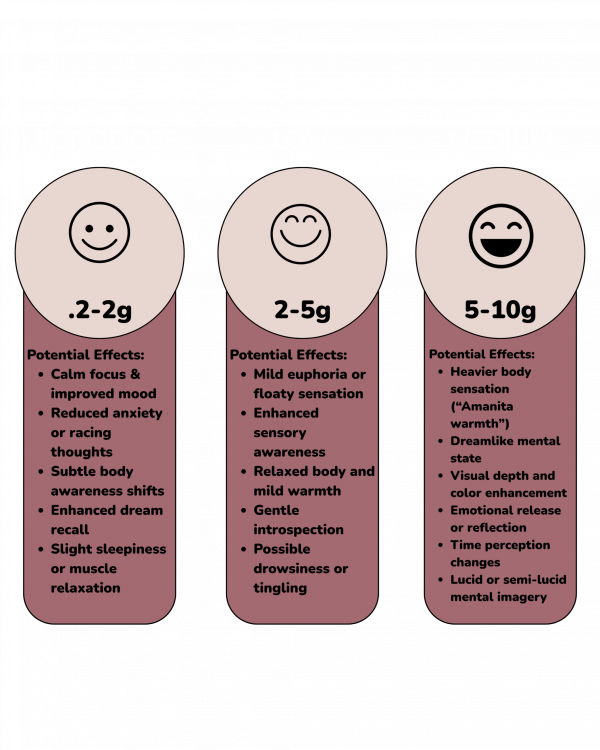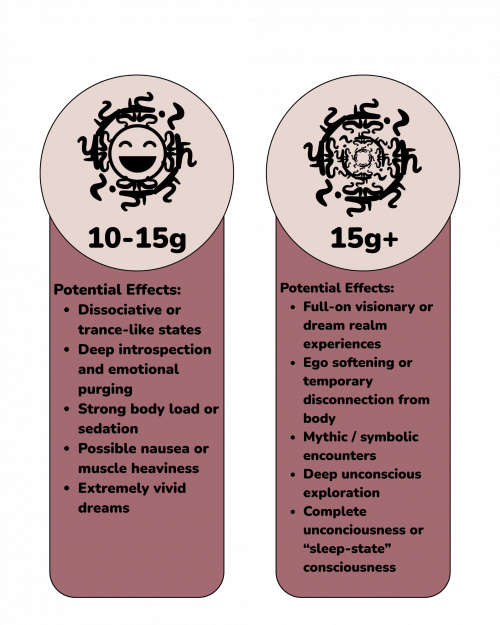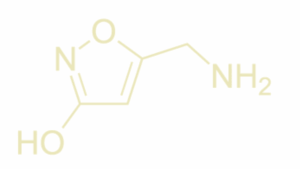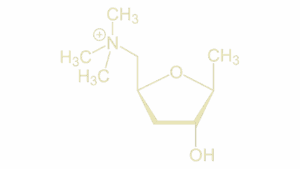Amanita Muscaria: Dosage, Pharmacology & Common Misconceptions
Amanita Muscaria has been misunderstood for centuries. Between the fearmongering, the pseudoscience, and the gas-station knockoffs, it’s easy to lose sight of what this mushroom actually is: a powerful, ancient entheogen that interacts with the brain in an entirely different way than psilocybin or other psychedelics.
Below is a grounded, experience-based look at Amanita – how to approach dosing, what’s really going on pharmacologically, and where the biggest misconceptions came from.
Amanita Muscaria Dosage Guide


Amanita Regalis (the brown-capped Northern variety):
- Microdose: 0.1–0.7g
- Low Dose: 0.7–1.5g
- Medium Dose: 1.5–3g
- Strong Dose: 3–5g
- Heroic Dose: 5g+
Amanita Pantherina (the darker, more potent species):
- Microdose: 0.05–0.5g
- Low Dose: 0.5–1g
- Medium Dose: 1–2g
- Strong Dose: 2–4g
- Heroic Dose: 4g+
1 gram of Amanita extract ≈ 5 grams of dried mushroom.
We recommend beginning with .5-2 grams of dried product for your first time. Work your way up from there as needed. Please do not take more than 4 grams dried for your first experience. For first timers we recommend starting off with 2-4 of the 500mg capsules. So around 1-2 grams for first experience is recommended. You can adjust this based on the product. For example (350mg Am gummies – the recommendation for a first timer would be 3-6 gummies. (some people prefer less but at 1-2 grams most people love this as an introductory dose)
To learn more about how to customize your Amanita experience check out our Amanita tea recipe 🙂
If you’re looking to explore microdosing, start with 0.5-1 gram, 2-3 times per day. Pay attention to your thoughts and how your reality shifts over time. Stay consistent for 2-3 weeks to feel the full effects.
The Pharmacology of Amanita Muscaria
Amanita Muscaria doesn’t work like psilocybin. It’s not serotonergic — it’s something entirely its own.
Instead of acting on serotonin receptors, Amanita’s effects come from three primary compounds that interact with GABA, glutamate, and acetylcholine systems in the brain. These are the same systems involved in calm, learning, and neural balance.

Muscimol – Calm Without the Sludge
Muscimol is the main psychoactive compound after Amanita is dried or properly prepared. It acts as a GABA-A receptor agonist – meaning it enhances your brain’s natural calming system, similar to how your body relaxes after meditation or sleep.
Unlike alcohol or benzodiazepines, which blanket-suppress brain activity, muscimol is selective and clear. The result is a relaxed, dreamlike, and introspective state that leaves your mind lucid rather than foggy.
Most users describe it as “lucid relaxation” – calm, but conscious.

Ibotenic Acid – From Focus to Dissociation
Ibotenic acid is the precursor to muscimol. It’s more active in raw mushrooms or those that haven’t been decarbed (heated or dried properly).
At low doses, ibotenic acid can actually feel stimulating – some describe it as mildly nootropic, with better focus and alertness.
At higher doses, or in non-decarbed mushrooms, it becomes dissociative and can cause nausea or confusion.
Proper drying or simmering transforms much of this ibotenic acid into muscimol, creating a smoother and safer experience. Still, some people prefer Amanita with higher ibotenic content for its more “electric” or stimulating edge – there’s no one-size-fits-all here.

Muscarine — The Forgotten Alkaloid with Nootropic Potential
Muscarine is present in smaller quantities in Amanita muscaria, but its role is still noteworthy. It works on the acetylcholine system, a network of receptors responsible for memory, attention, and neuromuscular communication. This is the same neurotransmitter system targeted by many modern nootropic formulas, which aim to improve focus, cognition, and mental clarity.
While muscarine isn’t the star of the Amanita experience, its subtle presence may contribute to a heightened awareness of body, space, or mental function — part of the mushroom’s unique and multifaceted effect profile.

Synergy: The “Amanita Effect”
Muscimol, ibotenic acid, and muscarine interact in a way that’s hard to categorize — part sedative, part dissociative, part nootropic.
At lower doses, users report better sleep, vivid dreams, and a grounded sense of calm.
At higher doses, it can become visionary, euphoric, or even challenging — much like deep meditation or lucid dreaming taken to the extreme.
In short: Amanita Muscaria offers relaxation, introspection, and spiritual depth through an entirely different neurochemical pathway than serotonergic psychedelics. When prepared properly, it becomes a gentle but powerful ally for the nervous system and the psyche.
Common Misconceptions About Amanita
“Amanita is Toxic or Poisonous”
This myth has been repeated for generations, but it’s mostly based on bad science and old propaganda.
Early studies injected pure ibotenic acid directly into animal brains (yes, literally into the brain tissue) and concluded it was toxic. If you did the same with aspirin, it would kill the subject too.
Most “bad trips” or poisonings came from people eating raw mushrooms straight from the ground. Fresh Amanita contains more ibotenic acid and moisture, both of which can cause nausea.
All Amanita products sold by Amentara are fully dried (“cracker dry”) and properly prepared.
The “poisonous mushroom” label dates back to the Crusades and witch hunts, when anything associated with pre-Christian spiritual practice was demonized. Later, during the Rockefeller era, education systems reinforced the same narratives. Amanita was a threat to orthodoxy — so it was branded toxic.
“Amanita is Psychedelic”
Not exactly. Amanita is psychoactive, but it’s not a “psychedelic” in the classic serotonin-based sense.
Instead of fractal visuals and ego dissolution, Amanita experiences are dreamlike, dissociative, and introspective.
Some find them profoundly healing and euphoric; others find them confusing or intense — it depends heavily on preparation, dose, and mindset.
Think of it as a lucid-dream mushroom rather than a psilocybin-style trip.
“Amanita is Illegal”
Not true. Amanita Muscaria is 100% legal to possess, sell, and use in every U.S. state except Louisiana.
It’s also legal in most countries worldwide, with a few exceptions like Australia, the Netherlands, and Romania.
Fake Amanita Products
Unfortunately, the market is flooded with fake or adulterated “Amanita” products — often sold in gas stations or sketchy online shops.
Lab results and user reports have revealed that many of these contain research chemicals like 4-AcO-DMT (a potent psychedelic), synthetic cannabinoids, or even benzodiazepine analogues.
They’re sold under flashy branding with “proprietary blends” that hide the real ingredients, leading to panic, hospitalization, and mistrust.
This black-market chaos has nothing to do with authentic Amanita Muscaria. It’s driven by prohibition and profit — and it’s exactly why education and transparency are so important.
If you want to understand how to spot fake products and protect yourself, check out this video:
🎥 The Truth About Gas Station “Mushroom” Products
In Summary
Amanita Muscaria isn’t the villain it’s been made out to be — it’s a complex, sacred, and deeply calming mushroom when approached with respect.
Not psychedelic in the psilocybin sense, but absolutely psychoactive
Not toxic, just misunderstood
Legal, accessible, and ancient
A powerful tool for nervous system healing, dreamwork, and introspection
Start small, source responsibly, and let the mushroom teach you at its own pace.
Amentara’s Amanita capsules, extracts, and gummies are all properly decarbed, lab-tested, and sourced with integrity — so you can explore this ancient medicine safely and consciously.

